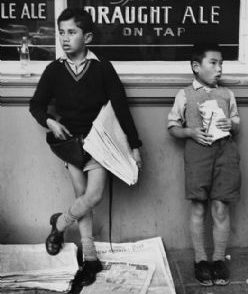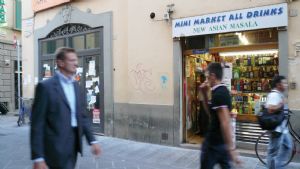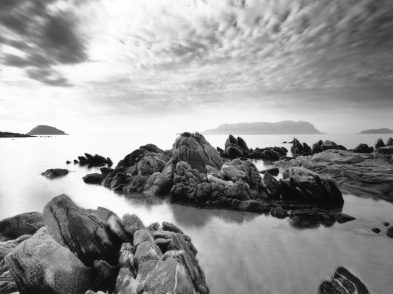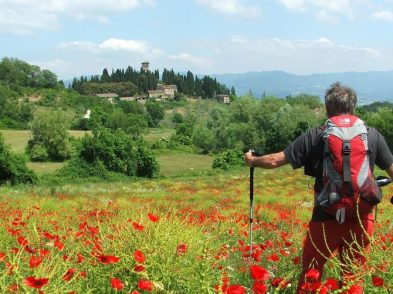On the first leg of this adventure (read the first part) we began a trip off the beaten track of well-known monuments and headed south from Florence by car by way of Castellina in
Chianti, Castelnuovo Berardenga, Poggibonsi and San Gimignano. The tour continues in Colle Val d’Elsa.
Situated just a few kilometres to the south of Poggibonsi, Colle Val d’Elsa has several claims to fame. It’s the birthplace of Arnolfo di Cambio, the architect of Florence’s
medieval monuments; it was a significant centre for paper production during the Middle Ages; and since the nineteenth century it’s been home to the most important crystal industry in Italy, covering 95 percent of the national, and 15 percent of the world, market. The Museo del Cristallo traces the history of this activity, beginning in 1820, though the exhibit also includes pieces from the pre-industrial era. In the Museo Civico e Diocesano d’Arte Sacra you can
see local art from the sixth through to the twentieth centuries, whereas Colle’s Museo Archeologico presents material found locally from the chalcolithic period (the end of the Stone Age) to medieval times.
Further southwest, along winding roads, are two small fortified towns, Casole d’Elsa and Radicondoli, with museums and other temptations for the eye as well as the palate. In Casole, the Museo Archeologico e della Collegiata houses local archeological finds, medieval sculpture and paintings from the Middle Ages to the Baroque. Radicondoli offers something for science buffs: the Museo dell’Energia, with didactic displays about the discovery of energy, including
the soffioni e lagoni del Senese studied at the end of the eighteenth century by Paolo Mascagni, the anatomist famous for his research on lymphatic vessels.
The southernmost point of this itinerary is Orgia, a locality in the commune of Sovicille, where you’ll find a museum that is as fascinating for children as it is for adults. The Museo del Bosco, installed in a restored farmhouse, is an ethnographic museum devoted to man’s life and work in the woods. The story is told with didactic panels as well as tools and implements. Moreover, five different walks, totalling 50 kilometres, illustrate the activities of wood-cutters, wood-carters, and carbonari or charcoal maker’s (spaghetti alla carbonara is ‘charcoal makers’ spaghetti’).
From Orgia, start heading to Siena, the last destination on this itinerary. Those who wind their way along the secondary road in the direction of Rosia rather than taking the SS 223 or the SS 73, will pass a wonderful restaurant, Le Torri di Stigliano, in the small cluster of houses that forms the village of Stigliano. Eat there if you possibly can. This part of the countryside is wonderful to ramble through, whether on foot or horseback, or in a slow-moving vehicle. Although largely agricultural, the land is anything but monotonous. Every twist and bend in the road can hold a surprise, though not necessarily as exciting as the one I had when I helped chase a large runaway sow through one of these villages. You’ll feast your eyes on picturesquely dilapidated farmhouses, abandoned country churches and magnificent villas such as the seventeenth-century Chigi Villa Cetinale, which belonged to the late Lord Lambton, who did wonders restoring the entire estate. The land is idyllic in all seasons. Thanks to the deep red colour of the iron-rich soil, not even the most dismal, rainy winter day can make the scene look drab.
Avoid getting onto the SS 73 until you absolutely have to, at Piaggiarella. Very soon on your right you’ll see a sign for Le Volte Basse (you’ll be about 8 kilometres from Siena), and if you have time, look at Villa le Volte, built by Baldassare Peruzzi for Sigismondo Chigi shortly before he designed the famous Villa Farnesina in Rome for his brother Agostino Chigi.
Siena is so well known that any introductory words are superfluous. The Fondazione Musei Senesi (http://www.museisenesi.org/)
promotes four sites in Siena, of which the Museo Civico e Torre del Mangia (88 metres high), in the Palazzo Pubblico, is world famous thanks to Lorenzetti’s frescoes of Good and Bad Government, and Martini’s Maestà. Less well known is the Museo Diocesano di Arte Sacra in the Oratory of S.Bernardino, with paintings from the Middle Ages and Renaissance, fifteenth-century sculpture, as well as examples of goldsmiths’ work. In the former monastery of the Camaldolese you’ll find the Museo di Storia Naturale with sections devoted to geology, zoology, anatomy and botany. For anyone interested in plants, the University of Siena’s Botanic Garden and Herbarium (reservations needed to visit the latter) are a must.
If, as I suspect, you have spent hours dutifully visiting all of the above museums, you will now be overcome by fatigue and need to sit down and let it all sink in. Assuming that you’re still in Siena, I suggest you look for an oasis well out of the centre of town. Explore the streets leading towards Siena’s remarkably well preserved city walls. My favourite area is the southwest quarter. Look for an enticing bar or a place offering more substantial refreshment, where you can relax and take in the glorious landscape, the very same landscape that Lorenzetti and his compatriots so evocatively portrayed in the frescoes you’ve just admired.







